

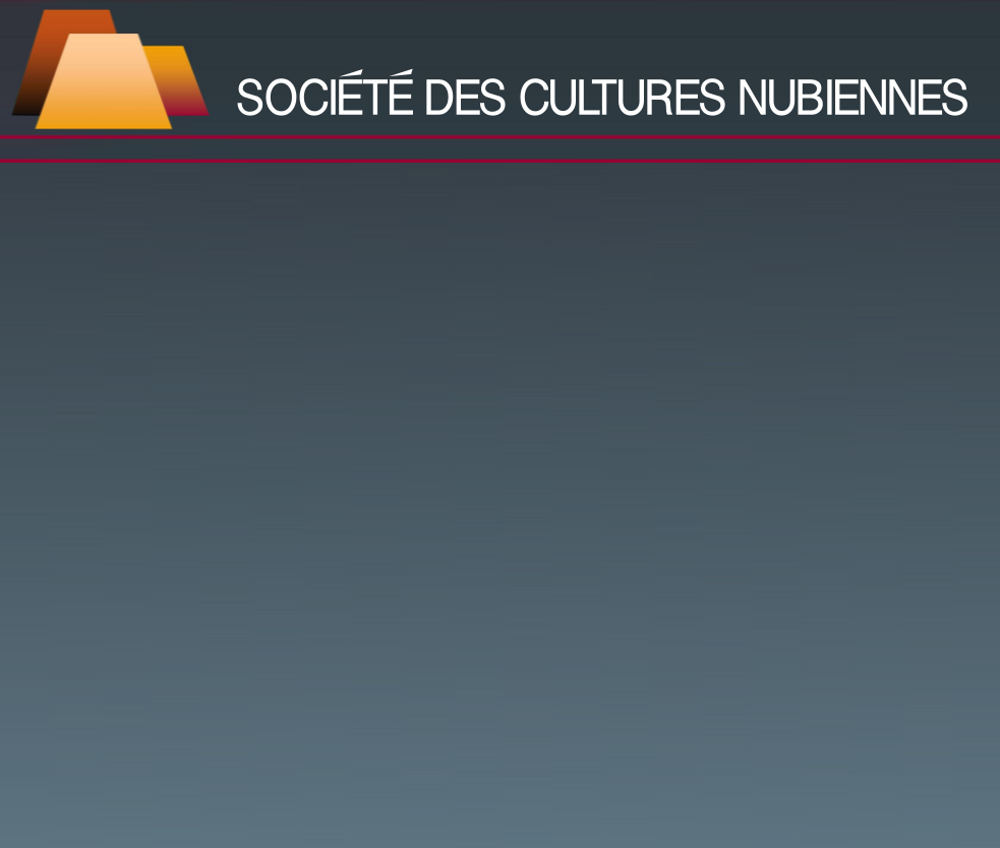
|
ABOU SIMBEL SITE
The two hemi-speos temples of Ibsamboul (the name given to Abu Simbel during the Turkish period) are located on the west bank of the Nile, at 280 km to the south of the First Cataract. They are dug into the two last hillocks of sandstone of the Libyan chain, once called Meha and Ibchek.
Inscriptions of the Old and Middle Kingdom indicate that the area was dedicated to the goddess of the western hills, Hathor of Ibchek.
The great temple honours Ramses II, deified in life, and the second his wife the queen Nefertari. The sovereigns are associated with the gods Amun-Re of Thebes, Re-Horakhty of Heliopolis, Ptah of Memphis and Hathor of Dendera and Ibchek.
At the beginning of the XIX Century, two archaeological missions are conducted first by Jean-Francois Champollion and then by Richard Lepsius. Let us listen to Champollion: 'The interior is worthy, but it is an arduous task to visit it. The sands have closed the entrance. We had it swept away, so as to secure as well as possible the small passage that we had made. I thought I stood at the mouth of an oven and, sliding bodily into the temple, I found myself in an atmosphere heated to 52 degrees. We visited this astonishing excavation, candle in hand'. |
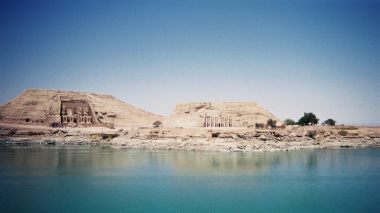 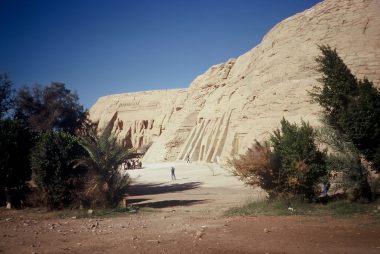 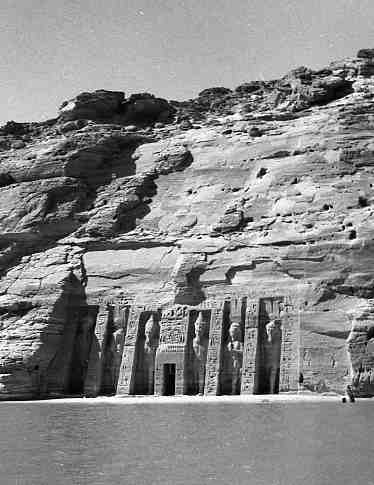 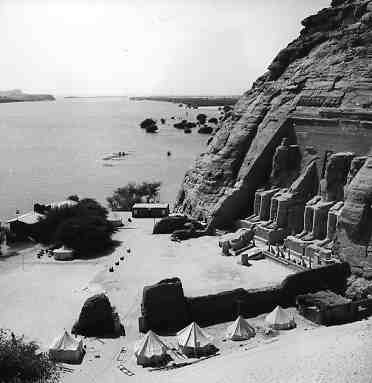 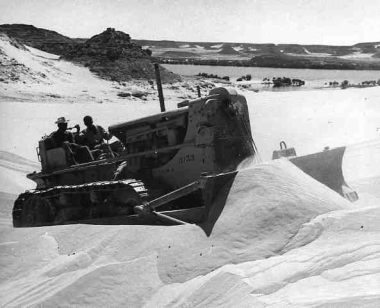 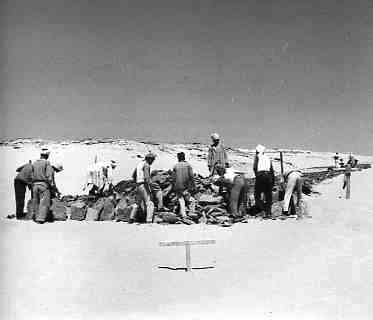 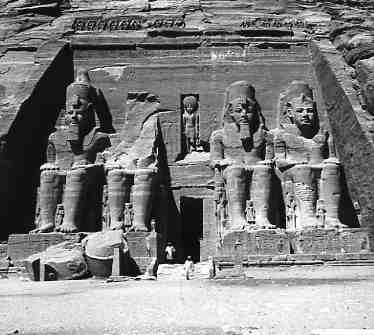 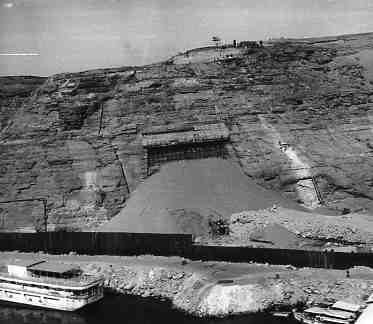 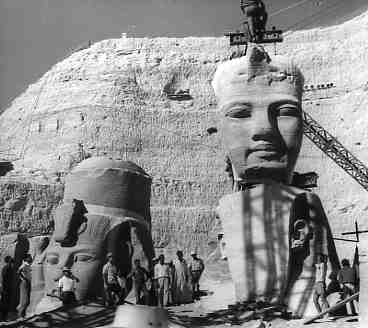 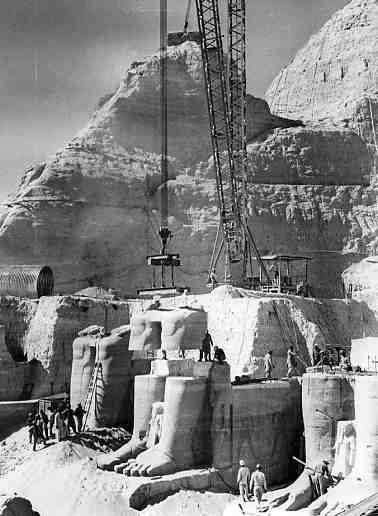 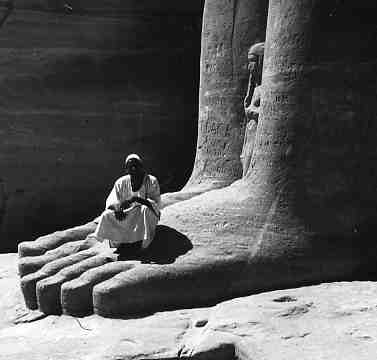 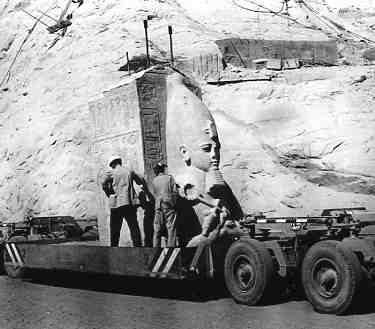 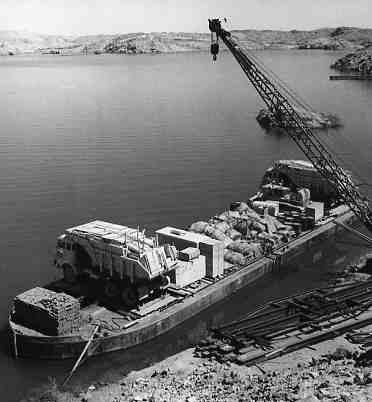 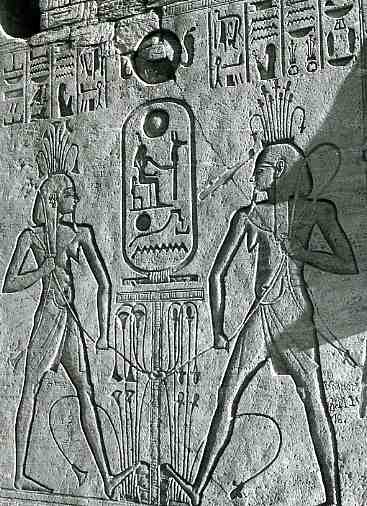 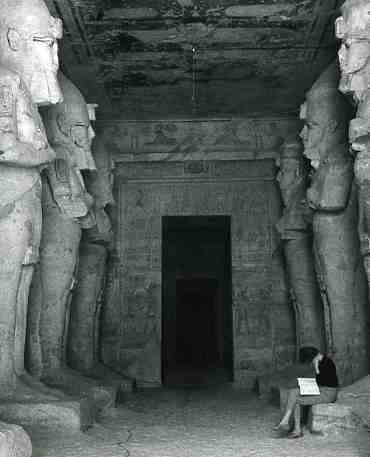 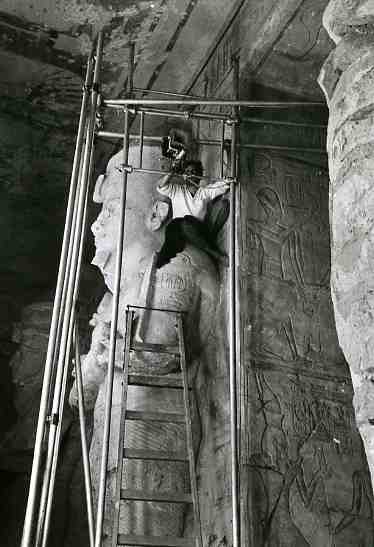 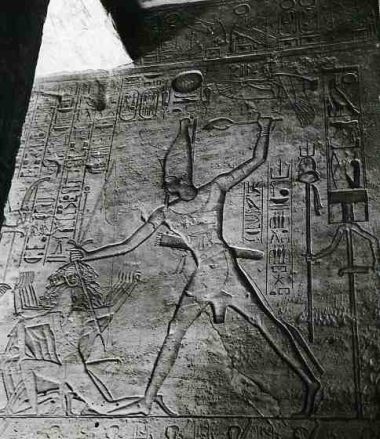 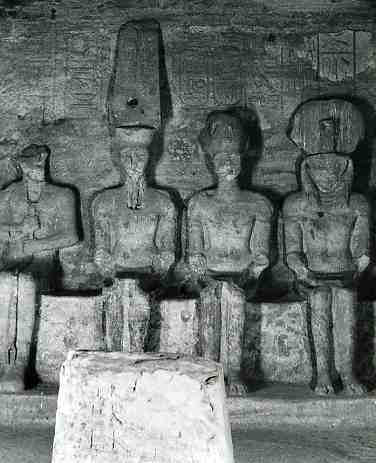 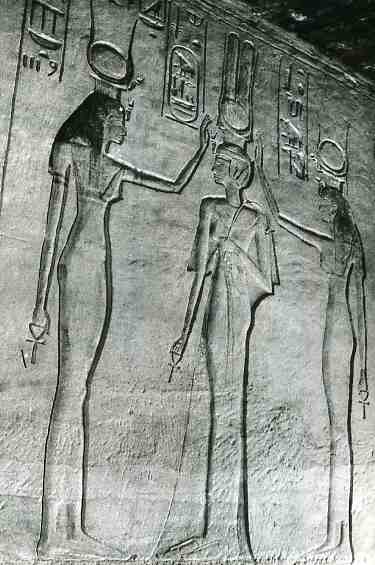 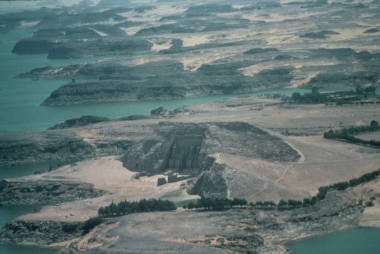 General view of the new site where the two temples dedicated to the egyptian king Ramses II and his great spouse, the queen Nefertari, have been rebuilt / Vue générale du nouveau site des deux sanctuaires d'Abou Simbel. Ces temples sont dédiés au souverain égyptien Ramsès II et à sa grande épouse royale, la reine Néfertari
Side view of the two temples of Abou Simbel on their new site / Vue latérale des deux sanctuaires d'Abou Simbel sur leur nouveau site
Facade of the Nefertari's temple on its original location near the Nile (Photo Rex Keating 1959) / Façade du temple de Néfertari situé sur son emplacement d'origine au bord du Nil (Photo Rex Keating 1959)
Facade of the great temple of Ramses II at Abou Simbel looking south. The Nile is at its highest but when the High Dam of Assouan will be finished, the water will rise above the summit of the mountain, about 60 meters up (Photo Rex Keating 1962) / Façade du grand temple de Ramsès II à Abou Simbel orientée sud. Le Nil est à son niveau le plus haut, mais lorsque le Haut-Barrage d'Assouan sera terminé, le futur lac Nubia (ou lac Nasser) atteindra le sommet de la montagne à environ 60 mètres (Photo Rex Keating 1962)
Construction of a road leading to the site of Abou Simbel (Photo Rex Keating) / Aménagement d'une route vers le chantier d'Abou Simbel (Photo Rex Keating)
On the way to the site of Abou Simbel (Photo R. Keating 1964) / Construction d'une voie d'accegrave;s au site d'Abou Simbel (Photo R. Keating 1964)
Great temple of Ramses II at Abou Simbel (Height 110 ft, width 127 ft.) The four colossi representing Ramses II (1290-1223 B.C) are about 67 ft. The entire work is 210 ft. in depth and hollowed out in the mountainside (Photo Unesco/Laurenza 1959) / Grand temple de Ramsès II à Abou Simbel (hauteur 33 m., largeur 38 m. ). Les quatre colosses représentant Ramsès II (1290-1223 avant J.-C.) ont une hauteur d'environ 20 m. L'ensemble dont la profondeur est de 63 m. est entièrement taillé dans le roc (Photo Unesco/Laurenza 1959)
The facade of the great temple of Ramses II has been covered with sand in order to protect the colossi during the dismantling operations. On the first rank, we observe a fence keeping away the water-flood. Behind the fence, entry of a tunnel allowing the access to the inside temple. On the top of the mountain, preparation of the futur site (Photo Unesco/Nenadovic 1965) / La façade du grand temple de Ramsès II a été recouverte de sable afin de protéger les sculptures durant le découpage des colosses. Au premier plan, on observe une palissade (batardeau) retenant l'inondation. Derrière cette palissade, entrée du tunnel permettant d'accéder à l'intérieur du temple. Au sommet de la montagne, travaux d'aménagement du futur site (PhotoUnesco Nenadovic 1965)
The head of one of the colossi of Ramses II, has been cut in two parts in order to move it toward the new site (Photo Unesco/Nenadovic 1965) / La tête d'un des colosses de Ramsès II vient d'être découpée en deux parties afin d'être transportée sur le nouveau site (Photo Unesco/Nenadovic 1965)
Final step of the dismantling of the colossi from the facade of the great temple (Photo Unesco/Nenadovic 1966) / Phase terminale du découpage des colosses de la façade du grand temple de Ramsès II (Photo Unesco/Nenadovic 1966)
Detail of the foot of one colossus, allowing to evaluate the scale of the statue's proportions (Photo Unesco/Laurenza 1959) / Détail du pied d'un des colosses permettant d'évaluer la dimension colossale des statues (Photo Unesco/Laurenza 1959)
Carriage of one osiriac pillar toward the new site of Abou Simbel. This pillar was inside the temple of Ramses II (Photo Unesco/Nenadovic 1966) / Transport vers le nouveau site d'un des piliers osiriaques qui se trouvait à l'intérieur du temple de Ramsès II (Photo Unesco/Nenadovic 1966)
Preliminary preparations for the preservation of the two temples of Abou Simbel (Photo R. Keating 1964) / Préparation du chantier en vue du sauvetage des deux temples d'Abou Simbel (Photo R. Keating 1964)
Bas-relief showing the Hapy god representative of the flood, linking the Upper and the Lower Egypt under the egg-shaped inscription of the name of Ramses II (Photo Rex Keating 1959) / Bas-relief des génies Hapy, représentatifs de l'inondation, unissant la Haute et la Basse Egypte sous le cartouche de Ramsès II (Photo Rex Keating 1959)
Osiriac statues of Ramses II, in the vestibule of the temple of Abou Simbel (Photo R. Keating 1959) / Statues osisiaques de Ramsès II dans le vestibule du temple d'Abou Simbel (Photo R. Keating 1959)
Photographer from the Center for Ancient Egyptian Studies working in the vestibule of the temple of Ramses II (Photo Rex Keating 1960) / Photographe du Centre des Etudes de l'Egypte Ancienne travaillant dans le vestibule du temple de Ramsès II (Photo R. Keating 1960)
Bas-relief of Ramses II showing the king about to kill his asiatic enemies who beg forgiveness. The egyptian king is followed by his Ka under the figure of an ensign (Photo R. Keating 1960) / Bas-relief de Ramsès II sur le point de sacrifier des Asiatiques qui implorent son pardon. Le souverain égyptien est suivi de son Ka sous forme de porte-enseigne (photo R. Keating 1960)
Sanctuary of the temple of Ramses II, with, from the left to the right, the statues of the gods Ptah, Amon, Ramses II deified and Ra-Horakhty (Photo R. Keating 1960) / Sanctuaire du temple de Ramsès II avec, de gauche à droite les dieux Ptah, Amon, Ramsès II divinisé et Ra-Horakhty (Photo R. Keating 1960)
In the temple of the queen Nefertari at Abou Simbel, bas-relief showing the queen between the goddesses Hathor and Isis (Photo R. Keating 1960) / Dans le temple de la reine Nefertari à Abou Simbel, bas-relief de la souveraine entre les déesses Hathor et Isis (Photo R. Keating 1960)
The new landscape of Abou Simbel with the nubian upstream lake after the construction of the High Dam of Assouan / Le nouvel environnement d'Abou Simbel avec le lac de retenue Nubia après la construction du Haut-Barrage d'Assouan
|
| In 1954, the Egyptian government decided to build the Aswan High Dam. Unesco, whose constituting principle is the preservation and the protection of works of art and historical monuments, launched an appeal on the 8th of March 1960, for a joint effort to save the Nubian temples. Between 1964 and 1968, the two buildings are dismantled and reconstructed 65 metres higher up. The work costs approximately 40 million dollars.
The operation is carried out in six phases: - Disengaging the temples, by removing the upper part of he hills in which they had been built (30m above the great temple and up to 80cm of the ceilings). Thus, 300 000 tons of rocks are displaced without the use of explosives, which could have run the risk of damaging the monuments. - At the same time, building a provisional dike that would prevent the waters from flooding the temples while they were being cut into sections and taken away, of some 370 m in length - Cutting into sections of the temples into 1035 blocks, some weighing up to 30 tons. This was the most delicate phase given the friability of the sandstone. It was necessary to reinforce the stone by injections of a synthetic resin to facilitate the cutting by saw. - Numbering and transfer of the blocks to a storage area. - Re-assemblage of the temples on a superstructure in concrete allowing for the better attachment of the blocks, while maintaining the original orientation and the respective positions of the hemi-speos - Reconstitution of the original hills, by building vaults in concrete to support a revetment of rocks, similar to that which surrounded the temples originally
The inauguration took place on the 22 September 1968, but the work continues until 1972. Nearly 900 people, including some fifty foreign technicians and engineers and forty Egyptian engineers work during six years. Nubian workmen, despite the preparation of their exodus, participate in the work to save the temples from their well beloved valley. When one arrives by boat, the view of these ruins is grandiose. What was it like in the past? The banks of the Nile where like those that we observe today in Sudanese Nubia: fields filling the narrow band of soil strewn with acacia trees. The two hemi-speos dominated this area of greenery. Across the river, on the eastern bank, an oasis displayed its cultivations, its palm-trees and its sycamores.
The great temple of Re-Horakhty - Ramses II This ensemble is unique in its architectural conception, is enlarged with a forecourt, an arrangement that is dominated by four colossi of the royal effigy.Before accessing the sanctuary, one notes: - To the north, the chapel of Re-Horakhty, dedicated to the cult of the sun. It is oriented to the east. At the time it was cleared of wind blown sand, the archaeologists discovered two important statues: a scarab wearing a disc decorated with a cobra, assimilated to the rising sun Kheper, and a baboon wearing the crescent and the full moon. - To the south, the chapel of Thoth only has the vestiges of a pylon. However, it is characterised by a rectangular speos decorated with offering scenes. On the west wall we observe a double scene where Ramses offers cartouches containing his titles (an ensemble of the titles attributed to a person) to Amun of Napata and to Re-Horakhty. - On the terrace of the great temple, twenty Osiriac statues and of Horus dominate a dedicatory band. Several stela are placed on the walls of the temple at the level of the terrace. The famous marriage stela (at the south east) commemorates the union of Ramses in the 34th year of his reign: 41 lines of text are surmounted by a scene where the king, seated in a kiosk, receives the princess Naptera rebaptised Maatneperure and her father the Hittite king, Khetasar. - The façade of the great temple is colossal (33m high, 38m wide and 63m deep). Trapezoidal in shape, reminiscent of a pylon, it is cut into the rock face by horizontal steps. * It is bordered by a torus surmounted by the famous Egyptian cornice, which carries a hieroglyphic text and royal cartouches. A frieze of 22 sculpted cynocephali crowns the ensemble. * The four colossi that decorate the entrance are an integral part of the mountain. They show the effigy of Ramses II seated on his throne. Their dimensions are impressive: 20m high. However the second colossus was destroyed by an earthquake, most likely two years after the first jubilee of the king. * Between the legs of the colossi, statues represent some members of the royal family, amongst them the queen mother Tuy and Nefertari. * In a niche, above the entrance doorway, one sees the effigy of Re-Horakhty to whom the temple is dedicated. He is depicted with a falcon's head, wearing a solar disc with uraeus, and holds the sceptre ouser (a baton with a jackal's head symbolising 'power') and the goddess Maat. The reading of this cryptogram gives the coronation name of Ramses: Ouser-Maat-Re. On each side, the double image of the king offers Maat to the central figure that is his own representation. * In the passage leading to the interior of the temple, the sign sematauy (a sign symbolising the union of Upper and Lower Egypt), is confirmed by the Hapy genies. It is surmounted by the royal cartouche (photo Rex Keating). Below, there are captives in chains: on the south side, Africans, and on the north side, Asians.
The interior of the temple presents: - A first hypostyle hall that replaces the porticoed court of the classical temples with on each side Treasury rooms. - A second hypostyle hall - A vestibule from which extend two chapels - A sanctuary
The first room is consecrated to the glory of Ramses, with to the north the famous battle of Kadesh. The central alley is bordered by two ranges of pillars flanked by eight statues with osiriac attributes. On the sides of the pillars, the king makes offerings to different deities such as Isis, Hathor of Ibcheck, Thot, Osiris, Min... (photos Rex Keating). In the Treasury, the walls are covered with offering scenes. Questions arise as to the reason for and the form of these eight long corridors: was the gold from Nubia kept in some of them? Where cults practiced for the deities honoured in the temple?
The second room is characterised by four pillars decorated by reliefs. They show the rite of embracing carried out by the divinities Anukis, Satis, Hathor and Mut. On the walls, the bark of the deified Ramses is carried by the priests.
The vestibule contains offering scenes.
The sanctuary confirms the essential function of the temple, a place of hierophany (contact between the visible and invisible world) through the four divine statues: Ptah, Amun-Re, the deified Ramses and Re-Horakhty. All apart from Ptah have a solar characteristic. At the solstices, they are regenerated twice a year by the rays of the sun.
This temple-speos built in the hill of Meha is in contact with the chtonian world inhabited by the divine powers. In this monument called the Castle of a thousand years, Ramses the god is given equal standing with the three other divinities and possesses their powers (Kaou). The four colossi of the façade, with the traits of the king, are in reality the symbolisation of the divinities present in the sanctuary. One must not forget that the reign of Ramses II was marked by an increasing aridity. The first duty of the Egyptian sovereign is to apply the Maat, or Divine order of the Cosmos, when the country has need of new waters to nourish man and beast. Social cohesion is vital to his hold on power. Ramses II in his capacity as king-god must assume this role. To achieve this, he fuses with the major deities of the sanctuary. The four divine observers of the façade, have as their task to provoke an abundant flood when exiting from the Second Cataract. Before then the tradition held that the primordial waters of Nun came from the cliffs of the First Cataract, but this is no longer enough. For this reason, several temples-speos are built by Ramses II in Lower Nubia.
The small temple of Hathor-Nefertari The hemi-speos of Hathor, in the hill of Ibchek, is complementary to those of Meha. Nefertari is associated to it: the same is the case at Sedeinga with the Hut Tiy. The great royal wife is elevated to the function of the female origin of a god, the formative part of this god. For example, the feminine counterpart of Amun is the goddess Mut. Ramses the god confirms 'Nefertari for whom the sun rises' as his counterpart.
The façade is of great originality, but there is no doubt of the primacy of Ramses over his great wife. The cartouches of the king-god impose themselves from the entrance. Six colossal statues, in the classic walking position, form two symmetrical groups on each side of the door. They are separated by the buttresses covered in hieroglyphs. Two effigies of the king guard the entrance, then those of the queen whose attributes are related to the goddesses Hathor and Satis (the star Sothis), and then finally two representations of the king frame the previous ones. The statue located at the extreme south is the highest and measures 8.30m. Some have seen in this the ideal measure of the inundation at Hierakonpolis that brought forth the joy and happiness symbolised by Hathor. The inundation came from the South and the myth of the far one, illustrated in the temple of Dakke, makes reference to all the vicissitudes that the new waters had to face. Why is Nefertari associated with Satis? The flood brings the new waters at the same time as the star Sothis reappears, in the astronomical calculations, which had 'disappeared' during the 70 days preceding the inundation. Nefertari, through Sotis, for whom the sun rises, becomes Hathor, who confirms a plentiful flood.
The small temple includes a courtyard, a vestibule and a sanctuary. In the courtyard, all is grace and beauty. Ramses gives homage to the gods and presents Maat. He is confirmed in his sovereignty, protected by Khonsu. On the Hathor pillars, the queen holds a sistrum (a musical instrument specifically associated with Hathor). The walls have retained a part of their white and yellow colours related to the sunlight, to divine reflections and to Hathor 'the Golden One'. The vestibule is characterised by the representation of the bark in the shape of papyrus ombelle on which the cow, symbol of Hathor, stands. Ramses offers the nu pots to Amun-Re and Re-Horakhty. Nefertari pays homage to the Elephantine triad: Khnum, Satis and Anukis. Together, they honour the hippopotamus goddess Tauret 'the great'.
The sanctuary is dedicated to Hathor, mother-goddess, Great Nurse, Lady of Nubia, of whom Nefertari is the living image.
|
|